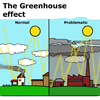The greenhouse effect is the trapping of heat from the Sun in the Earth's atmosphere. This has the effect of warming the Earth and making our planet hospitable to life. Without a greenhouse effect, the Earth would be very cold, about -18°C rather than our current average of 15°C.
Mars once had running water on its surface and may have supported life. Now, with only a very thin atmosphere left and virtually no greenhouse effect, it is now so cold that the only water is underground or in the polar ice caps.
Venus, on the other hand, has an average surface temperature of 482°C due to its incredibly dense atmosphere and run-away greenhouse effect.
With too much of a greenhouse effect we would become another Venus, not enough and we would freeze like Mars! The Earth needs the greenhouse effect, but just the right amount.
The "enhanced greenhouse effect"
If life on Earth exists because there is a greenhouse effect, what is
all the fuss about?
There is a delicate balance that exists on our tiny planet, between the heat energy arriving from the Sun, heat energy stored in the oceans, land, the atmosphere, plants and animals and the amount of energy which is re-emitted by the Earth back into space. If the balance changes in any way, our atmosphere either warms up or cools down, dramatically affecting our whole global climate.
In the past, the Earth's climate has gone through cycles of warmth and cold, for example, the Ice Ages. The warming of the atmosphere is caused by presence of carbon dioxide, methane, water vapour and other trace gases which are capable of absorbing thermal energy being re-radiated by the Earth's surface, trapping some of the heat before it can escape back into space. These gases are called "greenhouse gases". Many scientists think these past climatic cycles are created by periods of greater and lesser greenhouse gases in the atmosphere.
 About three-quarters of the greenhouse effect is due to water vapour
in the form of clouds and moisture in the air, with carbon dioxide being
the next most important gas. Over the past 200 years, additional carbon
dioxide gas has been pumped into the atmosphere due to burning of fossil
fuels and deforestation. Today, the concentration of carbon dioxide is
approximately 28% greater than in the pre-industrial 18th century. Similarly,
the other greenhouse gases have also increased because of human activities.
About three-quarters of the greenhouse effect is due to water vapour
in the form of clouds and moisture in the air, with carbon dioxide being
the next most important gas. Over the past 200 years, additional carbon
dioxide gas has been pumped into the atmosphere due to burning of fossil
fuels and deforestation. Today, the concentration of carbon dioxide is
approximately 28% greater than in the pre-industrial 18th century. Similarly,
the other greenhouse gases have also increased because of human activities.
The higher the concentrations of greenhouse gases in the atmosphere,
the more heat is trapped and the warmer the lower atmosphere (troposphere)
is likely to become, changing weather patterns and climate.
This adds to the natural greenhouse effect, producing an enhanced greenhouse effect or global warming. The impact of an enhanced greenhouse effect on the climate has been of increasing concern to scientists over the past decade. Possible effects of global warming have been modelled and some even measured already.
Possible effects on climate
The are still many different views and models of what may happen as a
consequence of the enhanced greenhouse effect. Most scientists now agree
on the possible effects within a range of predictions. As our models get
better and predictions more accurate, these figures are being refined.
Scientific modelling of the Earth's climate has show that the enhanced
greenhouse effect is likely to lead to global changes in a number of ways.
The world's average surface temperature has risen by between 0.3°C
and 0.6°C during the 20th century. By the end of the 21st century,
average temperatures are likely to be between 0.8°C and 4.5°C
higher. Some places will get more rain and storms, but others less. Cyclones
will be more common and will occur in latitudes much further away from
the equator than present.
Graph of average temperature over the past 100 years.
Sea levels are predicted to rise due to the expansion of water in the
oceans and the melting of the land ice in Antarctica and around the North
Pole. Scientists estimate that by the end of the 21st century, global
warming will raise average sea levels by between 13cm and 110cm above
present levels, flooding low-lying land. Records show that global sea
levels have already risen by between 10 and 25cm in the past 100 years.
Climate models predict the greatest warming will occur in the higher
latitudes (regions towards the poles) with the equatorial regions becoming
much cloudier and wetter. Some have compared it to the tropics expanding,
moving the mid-latitude dry regions in front of them.
The enhanced greenhouse effect will affect our whole way of life, especially
water resources, energy use, population movement and food production.
Bringing
back the balance
 Australia, like most industrialised countries produces huge quantities
of greenhouse gases each year. The only way that we can reduce our contribution
to global warming is to reduce our dependence on fossil fuels and replant
our lost trees. There is still much debate as to how we, as a nation,
should go about reducing our greenhouse gas output, but every little bit
helps. Oil will start running out in the next decade and cars will eventually
turn to electricity. Power stations in Australia are predominantly coal
powered, we need to supplement these power stations with wind, hydro and
solar power stations.
Australia, like most industrialised countries produces huge quantities
of greenhouse gases each year. The only way that we can reduce our contribution
to global warming is to reduce our dependence on fossil fuels and replant
our lost trees. There is still much debate as to how we, as a nation,
should go about reducing our greenhouse gas output, but every little bit
helps. Oil will start running out in the next decade and cars will eventually
turn to electricity. Power stations in Australia are predominantly coal
powered, we need to supplement these power stations with wind, hydro and
solar power stations.
| Copyright owned by the State of Victoria (Department of Education and Early Childhood Development). Used with Permission. |


